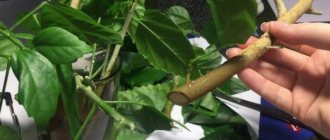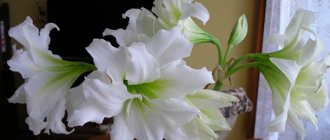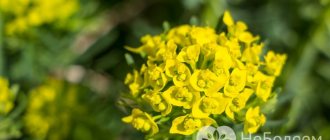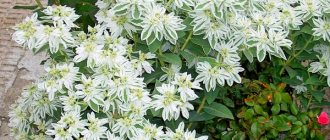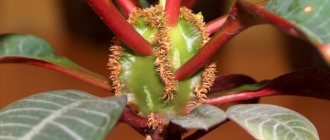Why is a transplant needed?
A milkweed transplant is needed in one of these cases.:
- The plant has grown. The roots of the milkweed are already cramped in the old pot, so the flower needs to be replanted.
- The roots of the milkweed have rotted and are affected by a fungal disease. In this case, fresh, uncontaminated soil is like an ambulance.
- The flower arrived from the store in a pot suitable for transportation, but not for living.
- The container from the store is still suitable, but the soil in it is a special substrate with the addition of growth stimulants.
Reproduction
Various types of milkweed are propagated by seeds and cuttings. Species that do not bloom indoors are easier to propagate by cuttings. Species that do not produce shoots, such as spurge, reproduce only by seeds.
Seeds obtained from indoor plants are stored for no more than a year. After this they lose their viability. They are sown in a container with soil mixture in early spring. Large seeds are buried slightly into the ground, and the container is covered with film. The temperature for germination must be at least 22°C. The first shoots can be seen after 2-3 weeks.
Cuttings are cut when pruning the plant in spring or mid-summer (it is convenient to root apical cuttings).
Shoots for rooting must be at least 10 cm in length. The lower leaves are removed from them, dried for 1-2 days and planted in sand.
It is necessary to periodically moisten the sand, and the cuttings can be covered with glass. Usually after 3-4 weeks they take root and are transplanted into separate pots.
Transplanting at home into another pot
Before transplanting, you need to prepare a container, nutrient mixture and drainage. How to choose a pot:
- Choose a pot taking into account the fact that the roots grow quickly. There should be enough space to install high-quality drainage, 2-3 centimeters wider than its predecessor.
- But the container should not be spacious, because spurge is ready to take up the space around itself. You should not take a growing pot, or a very deep one, also because the water stagnates in such a pot and the roots rot.
When replanting, place a layer of drainage on the bottom of the pot. For good breathability, it is advisable to sprinkle the drainage with rotten tree bark. Pebbles, expanded clay, and crushed tiles serve as drainage.
If a tall plant is being transplanted, heavy stones should be placed at the bottom along with drainage. In this case, the pot will not turn over due to gravity. For milkweed, the soil should be loose, permeable, slightly acidic .
We prepare the soil in one of the following ways:
- We take the following ingredients: peat, turf soil, leaf soil, sand. Mix them in equal parts.
- Mix leaf soil (2 parts), humus (3 parts), sand (2 parts).
- Take a store-bought nutrient substrate for succulents.
If you doubt the quality of the purchased mixture, treat it with water with the addition of potassium permanganate.
The transplant process consists of the following steps:
- Before replanting, water your indoor plant to make it easier to remove.
- Carefully remove the flower from the pot, while using a knife to help separate the edges of the soil from the walls of the pot.
- Inspect the root system, remove damaged or rotten roots.
- Gently shake off excess soil, but do not overdo it so as not to injure the roots.
- Using the transfer method, carefully transfer the plant into a previously prepared pot with drainage placed on the bottom and a thin layer of prepared substrate.
- Sprinkle the spurge with prepared soil.
- Press the surface moderately firmly with your hands.
- Pour warm water with bait.
Types of milkweed with names and photos
There are a huge number of varieties of milkweed; according to some sources, their number exceeds 2000. In Russia and the CIS countries alone, the culture is represented by 160 species. Most of them can be cultivated both at home and in the garden; we list the main popular types of garden and suitable for indoor growing of milkweed.
Euphorbia white-veined
Herbaceous perennial native to the island. Madagascar, producing shoots 1.5 meters high. At a young age it does not branch; at a more mature age it produces weak side shoots. The stem in the lower part is cylindrical, woody, in the upper part it has a pronounced five-rib section with traces of rough scars from fallen leaves. Grown as an indoor crop, the color is small and inconspicuous. It is characterized by rapid growth and a tendency to self-sowing.
Euphorbia ribbed
The second name of the species is comb. It is of Mexican origin and is very similar in appearance to the white-veined variety. The leaves are dark green, with pronounced veining. The trunk is ribbed, heavily spiked. The bracts are light pink.
Euphorbia brilliant (beautiful)
A very tall variety, reaching 2 m in height. The surface of the stem is cactus-shaped, lumpy, dark gray in color, with a large number of sharp cone-shaped spines. With age, the stem becomes bare from below, exposing 3-centimeter thorns. The bracts are brightly colored and can be scarlet, orange, beige, yellow or pink.
Euphorbia triangular
Inhabitant of desert regions in the southwest of the African continent. A tall species with shoots tightly pressed to each other, growing strictly vertically. The stems are strongly ribbed with three flat edges on which claw-shaped spines are concentrated. From the axillary buds grow spines and spade-shaped leaves, the length of which does not exceed 5 cm. Flowering of this variety is an extremely rare occurrence. Euphorbia triangular is propagated vegetatively using cuttings or rooted leaves.
This species has varieties in which the shoots are dark green and the foliage is red. They are very popular among gardeners due to the fact that, unlike flowering varieties, they remain decorative throughout the growing season.
Euphorbia beautiful (poinsettia)
This particular variety is called the “Christmas star”. It blooms with the onset of winter, blooming brightly in a rich scarlet color. It is a highly branched tall shrub and, at home, a small houseplant that bursts with bright color on Christmas Eve. In addition to this well-known one, there are many other varietal varieties of poiscentia, the bracts of which have a different color - orange, yellow, pink and others.
Euphorbia "jellyfish head"
The origin of the species is the southern tip of the African continent. It is a perennial with strongly branching shoots that grow horizontally and are prone to lodging. The appearance of this milkweed resembles a tangled ball of snakes. The shoots are fleshy, gray-green in color, with purple spots. The leaves are small, inconspicuous, narrowly belt-shaped. With age they remain only at the top. Unlike other species, the flowering of the “jellyfish head” does not have decorative value and is lost against the background of the spectacular appearance of its stems.
Euphorbia obese
Absolutely unlike other varieties, it has a thick spherical stem, more reminiscent of a cactus. At a young age, it has the shape of a perfect ball, then it stretches upward and resembles a baseball in outline. The stem is octagonal, about 30 cm, does not branch. It blooms in dense inflorescences that look like small green cones.
Euphorbia enopla
This species, even more than the previous one, has an external resemblance to a cactus. The cylindrical shoots are strongly branched along the entire length, have faintly pronounced ribs, planted with large curved spines. It can reach a height of 1 m. Flowers are formed in the apical part, the bracts are painted bright red.
In open ground
They need to be replanted into open areas in the spring, when the danger of frost has passed.- We need to select the area where we want to transplant the plant. Many garden species grow well outdoors. In the sun or in the shade - depends on the type of milkweed. Heavy and overly moist soil will not suit it.
- Before replanting, loosen the soil.
- If the acidity is high, liming can be done.
- Form a hole in the selected area. Wide enough to accommodate spurge with roots and drainage.
- When planting in open ground, do not forget about drainage.
Fill the hole for planting milkweed with pebbles or expanded clay so that they occupy 1/3 of the space. - Sprinkle compost or rotted bark on top.
- Using the transshipment method, we place a plant with a root clod of soil in the hole.
- Sprinkle with soil with added peat and sand.
- We dig a support nearby to tie up the spurge.
- Mulch with sawdust, humus or peat.
- Further care for the transplanted plant consists of watering and removing dry branches.
When working in the garden with milkweed, it is advisable to wear gloves.
Description of milkweed with photo
The birthplace of culture is the African continent. Madagascar and Central America. The botanical name of the plant is euphorbia; it is the most basic and most numerous representative of the Euphorbiaceae family of the same name. It looks like grass, shrubs, and in rare cases, trees. The appearance of representatives of the genus can also be very diverse. With smooth, leafy or prickly shoots, cactus-shaped, columnar and others. A common property, like all euphorbias, is the presence of milky sap in all parts of the plant, which, like all members of the family, in its pure form is caustic and toxic. Herbaceous forms of milkweed can have either a one-year or perennial life cycle. The shoots are most often of an ascending type, up to strictly vertical, but there are creeping types (“jellyfish head”) and spherical ones, which do not give lateral branches at all.
The height of milkweed varieties varies within very significant limits, from a few centimeters in dwarf representatives to exceeding human height. During flowering, in the upper part of the shoots, the leaves turn into bright bracts, creating the impression of a smooth transition into a small but bright bouquet.
Euphorbia is a poisonous crop that is not recommended to be grown in areas where there may be accidental contact with children or pets.
Post-procedure care
Post-procedure care includes:
- After transplanting the spurge into a new pot, it should be watered with settled warm water.
- We take the euphorbia transplanted into a new pot and place it in a lighted place, preferably without hot sun and drafts. The light should be diffused.
- Next, the plant should be sprayed to avoid drying out the soil.
You can read how to care for milkweed in general here.
What to do if the plant does not take root?
Having survived the transplantation process, the plant experiences stress and must go through a period of adaptation. But, if the recovery process is delayed, then it is necessary to understand the reason and take measures:
- Perhaps the flower is hot, the clod of earth is too dry. Move it to a cooler place. Spray to increase air and soil humidity. And in the future, regularly water with warm, soft water.
- If there is a suspicion that the spurge is overly moistened, then you need to reduce watering: water only when the soil above is completely dry.
- If in this case there are no changes, then you need to dig up the plant and inspect the roots.
When inspecting the plant before planting, pay attention that if the roots are not watery, have not changed color, and the root system looks healthy, then you can change the soil.Perhaps there is a source of infection in the ground. Before transplanting, the roots should be treated with special means.
We invite you to read other useful articles about milkweed:
- Pruning milkweed.
- Diseases and pests of milkweed.
- Blooming milkweed.
Tips for gardeners: how to grow spurge on a windowsill
Euphorbias grow well and do not require complex care. They are able to store water in the stem and fleshy leaves, so frequent watering is not required. Some types of milkweed are more capricious, but if the basic care conditions are met, problems with this plant will not arise.
Tips for growing milkweed:
- Euphorbia tolerates high temperatures well, but it is advisable not to keep it at temperatures above 25 degrees. In winter, it is best to give the plant a rest period and reduce the temperature to 14 degrees.
- Some types of milkweed are more shade-loving than others, but all need adequate light. If there is enough light on the windowsill, then you need to accustom the flower gradually so that the sun's rays do not burn the leaves. When there is an excess of direct rays, the leaves begin to turn yellow and fall off. In winter, when there is little light, you need to take care of additional lighting.
- It is better to water spurge less often than the norm. Due to excess moisture, the roots rot and the plant dies. It is necessary to water when the soil is already completely dry, but has not yet begun to crack from dryness. In winter, watering is as rare as possible.
- You need to feed spurge with a special fertilizer for cacti. In summer, fertilizing is carried out three times; in winter, once is enough. It is not recommended to fertilize with nitrogenous fertilizers, as they cause the stems and leaves to crack.
- Euphorbias are accustomed to dry climates, so there is no need to humidify the air or spray it. Regular watering is sufficient. Spraying may be necessary if you decide to wash and wipe your flower.
- Euphorbia grows quickly. A young plant needs to be replanted annually, increasing the diameter of the pot, and old spurge can be replanted every 3 years to renew the soil.
If not properly cared for, the spurge may die or become deformed. Crooked stems often form due to insufficient lighting and lack of winter dormancy. The flower begins to reach for the light and bend




